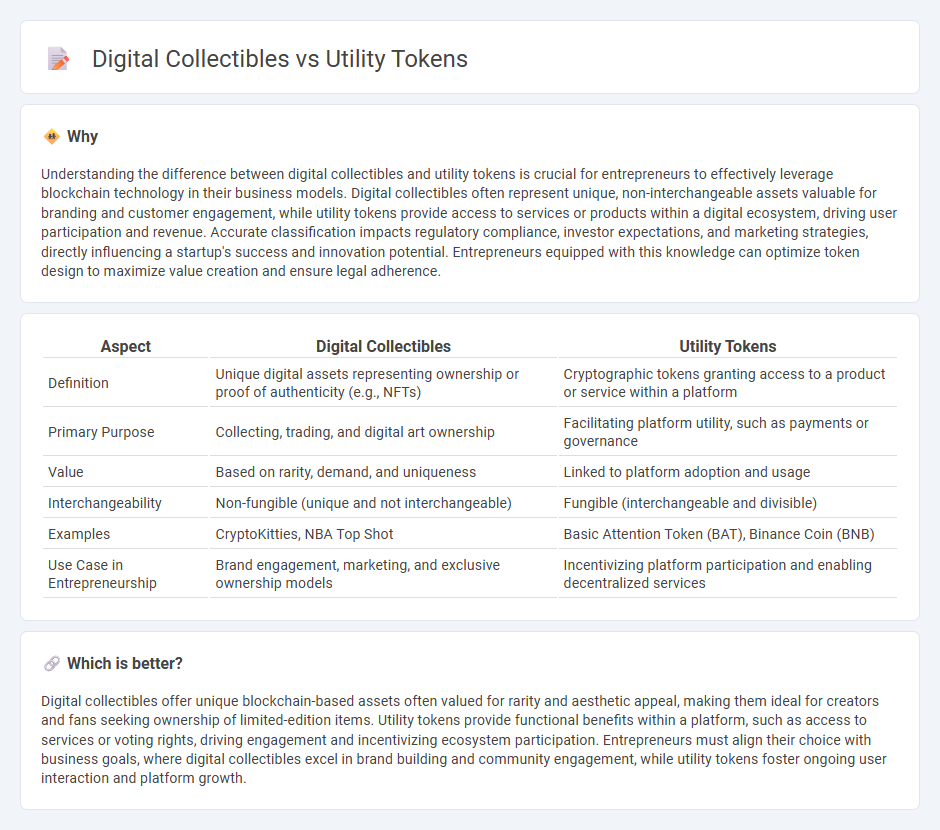
Digital collectibles represent unique, non-fungible assets that emphasize rarity and ownership in the digital economy, often appealing to collectors and enthusiasts. Utility tokens function as access keys within blockchain ecosystems, enabling users to leverage services or participate in decentralized applications, driving practical use cases beyond mere ownership. Explore the distinct roles and opportunities these assets present in entrepreneurship.
Why it is important
Understanding the difference between digital collectibles and utility tokens is crucial for entrepreneurs to effectively leverage blockchain technology in their business models. Digital collectibles often represent unique, non-interchangeable assets valuable for branding and customer engagement, while utility tokens provide access to services or products within a digital ecosystem, driving user participation and revenue. Accurate classification impacts regulatory compliance, investor expectations, and marketing strategies, directly influencing a startup's success and innovation potential. Entrepreneurs equipped with this knowledge can optimize token design to maximize value creation and ensure legal adherence.
Comparison Table
| Aspect | Digital Collectibles | Utility Tokens |
|---|---|---|
| Definition | Unique digital assets representing ownership or proof of authenticity (e.g., NFTs) | Cryptographic tokens granting access to a product or service within a platform |
| Primary Purpose | Collecting, trading, and digital art ownership | Facilitating platform utility, such as payments or governance |
| Value | Based on rarity, demand, and uniqueness | Linked to platform adoption and usage |
| Interchangeability | Non-fungible (unique and not interchangeable) | Fungible (interchangeable and divisible) |
| Examples | CryptoKitties, NBA Top Shot | Basic Attention Token (BAT), Binance Coin (BNB) |
| Use Case in Entrepreneurship | Brand engagement, marketing, and exclusive ownership models | Incentivizing platform participation and enabling decentralized services |
Which is better?
Digital collectibles offer unique blockchain-based assets often valued for rarity and aesthetic appeal, making them ideal for creators and fans seeking ownership of limited-edition items. Utility tokens provide functional benefits within a platform, such as access to services or voting rights, driving engagement and incentivizing ecosystem participation. Entrepreneurs must align their choice with business goals, where digital collectibles excel in brand building and community engagement, while utility tokens foster ongoing user interaction and platform growth.
Connection
Digital collectibles, also known as non-fungible tokens (NFTs), represent unique digital assets that entrepreneurs leverage to create exclusive products and experiences. Utility tokens function as digital assets granting holders access to a platform's services, fostering customer engagement and monetization in entrepreneurial ventures. The integration of digital collectibles with utility tokens enables startups to build innovative ecosystems that drive user interaction and generate new revenue streams.
Key Terms
Fungibility
Utility tokens are fungible digital assets designed to provide holders with access to specific services or rights within a blockchain ecosystem, enabling interchangeable use and seamless transactions. Digital collectibles, often represented as non-fungible tokens (NFTs), are unique, non-interchangeable items that emphasize scarcity and individual ownership, making each token distinct in value and characteristics. Explore the fundamental differences in fungibility and use cases between utility tokens and digital collectibles to understand their roles in the digital economy.
Ownership Rights
Utility tokens grant holders access to a platform's services or products, often functioning as a key to unlock features within decentralized applications. Digital collectibles, also known as non-fungible tokens (NFTs), emphasize unique ownership rights and provenance, proving authenticity and scarcity of digital assets. Explore the nuances of ownership rights between utility tokens and digital collectibles to better understand their roles in the blockchain ecosystem.
Use Case
Utility tokens are primarily designed to provide access to specific services or platforms within blockchain ecosystems, enabling features like transaction fees payment, governance voting, or reward distribution. Digital collectibles, such as NFTs, serve as unique, tradable assets representing ownership of digital art, music, or virtual items, emphasizing rarity and provenance rather than functional utility. Explore our detailed comparison for deeper insights into their distinct use cases and market impact.
Source and External Links
Security Tokens vs. Utility Tokens : A Concise Guide - Utility tokens are cryptocurrencies that provide access to specific services or products within a blockchain platform, created through ICOs and governed by smart contracts, distinct from security tokens because they don't represent ownership or profit sharing but can be traded and used for governance and ecosystem growth.
What are utility tokens and how do they work? | MoonPay - Utility tokens serve as access keys within blockchain ecosystems, created by deploying smart contracts on platforms like Ethereum, and distributed via methods including ICOs and airdrops, allowing holders to utilize services, participate in networks, and trade tokens on exchanges.
Utility tokens vs. security tokens: what are the differences? - Coinbase - Utility tokens grant access to services or products within a blockchain ecosystem without representing ownership, and are mostly unregulated, whereas security tokens signify ownership in an asset and comply with securities laws, with utility tokens often providing benefits like discounted fees or usage privileges.
 dowidth.com
dowidth.com